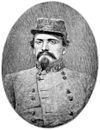Ohio Penitentiary
| File:Ohio Pen 1931.jpg Ohio Penitentiary viewed from Spring Street in 1931 | |
 | |
| Location | Columbus, Ohio |
|---|---|
| Coordinates | 39°58′3.25″N 83°0′29.92″W / 39.9675694°N 83.0083111°W |
| Status | Demolished |
| Population | 5,235 (as of 1955) |
| Opened | 1834 |
The Ohio Penitentiary, also known as the Ohio State Penitentiary, was a prison operated from 1834 to 1984 in downtown Columbus, Ohio, in what is now known as The Arena District.[1] The prison housed 5,235 prisoners at its peak in 1955. Conditions in the prison have been described as "primitive," and the facility was eventually replaced by the Southern Ohio Correctional Facility, a maximum security facility in Lucasville. During its operation, it housed several well-known inmates, including General John H. Morgan, who famously escaped the prison during the Civil War, "Bugs" Moran, O. Henry, Chester Himes, and Sam Sheppard, whose story is said to have inspired the movie The Fugitive. A separate facility for women prisoners was completed within the walls of the Ohio Penitentiary in 1837. The buildings were demolished in 1998.[2]
Fire
On April 21, 1930, a major fire killed 322 inmates and seriously injured 150.[3] The fire was the deadliest prison fire in United States history.[4] The fire broke out on scaffolding erected for the construction of an extension. Reports say that many guards refused to unlock cells when smoke entered the cell block and left the prisoners in their cells, although some did provide help. Some inmates overpowered a guard and took his keys, which they used to rescue other prisoners. However, a riot developed and firefighters arriving to fight the blaze were attacked with rocks.[5]
A cordon of penitentiary guards was deployed about the towering prison walls. Other squads took up vantage points in guard towers and by this time 500 soldiers from Fort Hayes, a local military post, were on the scene. Machine guns were placed at the gates and on the walls. Bayonets were fixed and the troopers were ordered to shoot to kill. A troop of National Guardsmen soon augmented the regulars, and 30 minutes after the fire started the prison was completely surrounded.[6]
The incident was the subject of then-inmate Chester Himes' story To What Red Hell, published in Esquire in 1934, as well as to his 1952 novel, Cast the First Stone, republished unabridged in 1998 as Yesterday Will Make You Cry.
Executions
In 1885, the penitentiary became the site for executions, which had been carried out by local law enforcement officials up to that time. At first, prisoners condemned to death were executed by hanging, but in 1897 the electric chair replaced the prison's gallows. A total of 315 prisoners, both men and women, were electrocuted between 1897 and 1963, when the death penalty was halted in Ohio.[7] A number of women served on death row in the prison and ultimately faced execution either by hanging or in the electric chair.
Riots
The prison was the site of the "Halloween Riot", on October 31, 1952, which left one inmate dead and four injured,[8] as well as the riot of August 1968, which ended with five dead inmates, five injured inmates and seven injured officers.[9]
Closure
After the closure of the Ohio Penitentiary in 1984,[7] the building stood vacant for more than a decade, though it was used as a training site for a time by the Ohio National Guard, was briefly known as "The Haunted Prison" for Halloween festivities, and attracted a number of urban explorers. The building also served as the setting for the 1985 made-for-TV movie "Love on the Run", starring Stephanie Zimbalist and Alec Baldwin. The state eventually sold it to the city of Columbus in 1995. The Burnham Square Condominiums, named after urban planner and architect Daniel Burnham, who designed Columbus's Union Station, and the Nationwide Arena now stand on the site of the former penitentiary.[10]
Among the wardens of the penitentiary was Charles C. Walcutt, a former general in the Union Army during the Civil War. The last Warden was T.D. Taylor.
Images
-
A cell block in the abandoned prison, shortly before demolition.
-
A cell in the abandoned prison, shortly before demolition.
-
The James Hospital stood in the courtyard of the prison.
-
Interior of the prison.
-
The courtyard of the abandoned prison.
-
Gate to the prison's courtyard.
See also
References
- ^ The Arena District
- ^ Ohio Penitentiary
- ^ Ohio Penitentiary Fire — Ohio History Central — A product of the Ohio Historical Society
- ^ ABC News: World's Deadliest Prison Fires (February 15,2012)
- ^ "This Day in History: Prisoners left to burn in Ohio fire". History Channel. Retrieved 14 February 2014.
- ^ "Columbus, OH State Penitentiary Fire Disaster, Apr 1930". Retrieved 2009-06-17.
- ^ a b Ohio Penitentiary - Ohio History Central - A product of the Ohio Historical Society
- ^ Ohio Penitentiary Riot (1952) - Ohio History Central - A product of the Ohio Historical Society
- ^ Ohio Penitentiary Riot (1968) - Ohio History Central - A product of the Ohio Historical Society
- ^ Columbus RetroMetro: City Scene Template:Wayback
External links
- Ohio Penitentiary, Ohio History Central
- The Ohio Penitentiary, Ohio Department of Rehabilitation and Correction
- Death of a Legend Book Closing on Another Chapter in Ohio History (a history of the Ohio Penitentiary), Ohio Department of Rehabilitation and Correction







